
The Valour class is a class of frigates built for the South African Navy. Part of the MEKO family of warships, the German shipbuilder Blohm+Voss officially designate the class as the MEKO A-200SAN.

The Halifax-class frigate, also referred to as the City class, is a class of multi-role patrol frigates that have served the Royal Canadian Navy since 1992. The class is the outcome of the Canadian Patrol Frigate Project, which dates to the mid-1970s. HMCS Halifax was the first of an eventual twelve Canadian-designed and Canadian-built vessels which combine traditional anti-submarine capabilities with systems to deal with surface and air threats as well. Ships of the class are named after capital cities of Canadian provinces, the capital of Canada, Ottawa, and the major cities of Calgary, Montreal, and Vancouver.
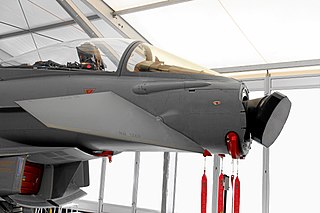
An active electronically scanned array (AESA) is a type of phased array antenna, which is a computer-controlled antenna array in which the beam of radio waves can be electronically steered to point in different directions without moving the antenna. In the AESA, each antenna element is connected to a small solid-state transmit/receive module (TRM) under the control of a computer, which performs the functions of a transmitter and/or receiver for the antenna. This contrasts with a passive electronically scanned array (PESA), in which all the antenna elements are connected to a single transmitter and/or receiver through phase shifters under the control of the computer. AESA's main use is in radar, and these are known as active phased array radar (APAR).
A low-probability-of-intercept radar (LPIR) is a radar employing measures to avoid detection by passive radar detection equipment while it is searching for a target or engaged in target tracking. This characteristic is desirable in a radar because it allows finding and tracking an opponent without alerting them to the radar's presence. This also protects the radar installation from anti-radiation missiles (ARMs).

The Type 81 surface-to-air missile (81式短距離地対空誘導弾) or Tan-SAM (短SAM) is a Japanese developed surface-to-air missile currently in service with the Japan Ground Self-Defense Force.

The AN/APG-66 radar is an X-band solid state medium range pulse-Doppler planar array radar originally designed by the Westinghouse Electric Corporation for use in early generations of the F-16 Fighting Falcon. Later F-16 variants use the AN/APG-68 or the AN/APG-83. This radar was employed in all domestic and export versions of the F-16A/B models throughout the production. Subsequent upgrades have been installed in many varying aircraft types including the U.S. Customs and Border Protection's C-550 Cessna Citation, US Navy P-3 Orion, and Piper PA-42 Cheyenne II's.

The Erieye radar system is an Airborne Early Warning and Control System (AEW&C) developed by Saab Electronic Defence Systems, formerly Ericsson Microwave Systems, of Sweden. It uses active electronically scanned array (AESA) technology. The Erieye is used on a variety of aircraft platforms, such as the Saab 340 and Embraer R-99. It has recently been implemented on the Bombardier Global 6000 aircraft as the GlobalEye.
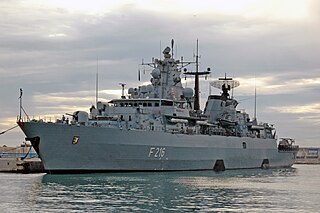
The F123 Brandenburg class is a class of German frigate. They were ordered by the German Navy in June 1989 and completed and commissioned between 1994 and 1996, replacing the Hamburg-class destroyers. The ships primarily carry out anti-submarine warfare (ASW), but they also contribute to local anti-aircraft defenses, the tactical command of squadrons, and surface-to-surface warfare operations. Together with the F124 Sachsen-class frigates, they are the mainstay of the German surface fleet.
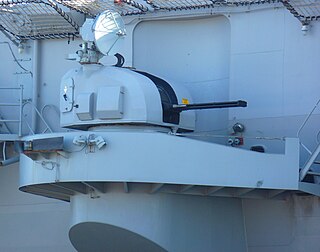
The Meroka CIWS is a Spanish Navy 12 barrelled 20 mm close-in weapon system (CIWS), using twelve Oerlikon 20 mm/12 guns mounted in 2 rows of 6 guns each. The system's primary purpose is defence against anti-ship missiles, and other precision guided weapons. However, it can also be employed against aircraft, watercraft, coastal targets, and floating mines. The weapon is mounted primarily on Spanish naval vessels, from frigate size upwards.

The Type 730 is a Chinese seven-barrelled 30 mm Gatling gun/rotary cannon CIWS. It has a PLA Navy designation H/PJ12. It is mounted in an enclosed automatic turret and directed by radar, and electro-optical tracking systems. The maximum rate of fire is 5800 rd/m, and the effective range is up to 3 km.

The Sukhoi Su-30MKK is a modification of the Sukhoi Su-30, incorporating advanced technology from the Sukhoi Su-35 variant. The Su-30MKK was developed by Sukhoi in 1997, as a result of a direct Request for tender between the Russian Federation and China. It is a heavy class, all-weather, long-range strike fighter, and like the Sukhoi Su-30, comparable to the American McDonnell Douglas F-15E Strike Eagle. The Sukhoi Su-30MK2 is a further improvement to Su-30MKK with upgraded avionics and maritime strike capabilities. The MKK and MK2 are currently operated by the People's Liberation Army Air Force, Indonesian Air Force, Vietnam People's Air Force, Venezuelan Air Force and the Ugandan Air Force.
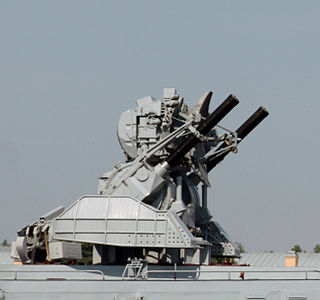
The Kortik close-in weapon system (CIWS) is a modern naval air defence gun-missile system deployed by the Russian Navy. Its export version is known as Kashtan, with the NATO designation CADS-N-1 Kashtan.
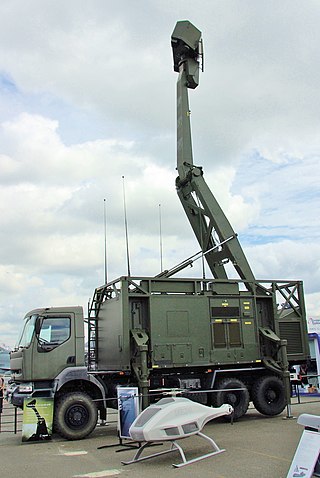
The Saab Giraffe Radar is a family of land and naval two- or three-dimensional G/H-band passive electronically scanned array radar-based surveillance and air defense command and control systems. It is tailored for operations with medium- and Short Range Air Defense (SHORAD) missile or gun systems, or for use as gap-fillers in a larger air defense system.
The Combat Aircraft Systems Development & Integration Centre (CASDIC) is a laboratory of the Indian Defence Research and Development Organisation (DRDO). Located in Bangalore, Karnataka, India, It is one of the two DRDO laboratories involved in the research and development of airborne electronic warfare and mission avionics systems.
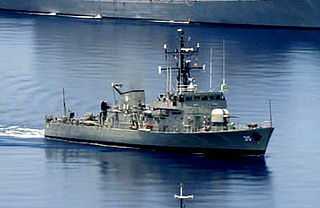
The BRP Emilio Jacinto (PS-35) is the lead ship of the Jacinto-class corvettes currently assigned to the Offshore Combat Force of the Philippine Fleet. She is one of few ships in the Philippine Navy equipped with modern systems after the completion of combat, navigation and weapon systems upgrade of her class in August 2019. She was originally called HMS Peacock (P239) during her service with the Royal Navy.

The MEKO 200 is a frigate design by the Blohm + Voss shipyard of Germany, as part of the MEKO family of warships.

HTMS Taksin (FFG-422), hull number 622, commissioned in 1995, is a modified version of the Chinese-made Type 053 frigate, designed and built by the China State Shipbuilding Corporation in Shanghai. Her sister ship, HTMS Naresuan was delivered in November 1995. The ships came at 2 billion baht each, less than the 8 billion baht claimed price tag for Western-built frigates.

The Denel 35 mm Dual Purpose Gun (35DPG) is an inner layer of defence (ILD) weapon system for warships built in South Africa by Denel Land Systems. It is currently in service on the Valour-class frigates of the South African Navy.
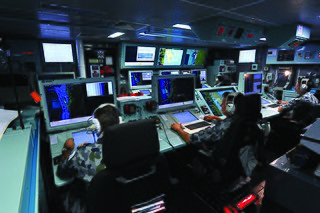
9LV is a Naval Combat Management System (CMS) from the Swedish company Saab. The 9LV was established when Philips Teleindustri AB, a subsidiary of Philips of the Netherlands, was selected as the supplier of the torpedo and dual-purpose gun fire control system including a radar fire control director for the Royal Swedish Navy Norrköping-class torpedo boats.

Mark 63 Gun Fire Control System is a gun fire-control system made up of AN/SPG-34 radar tracker and the Mark 29 gun sight. They were usually equipped for the control of twin QF 4-inch naval gun Mk XVI and Mk.33 twin 3"/50 cal guns.


















